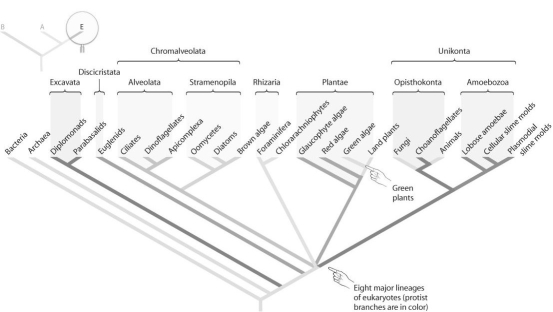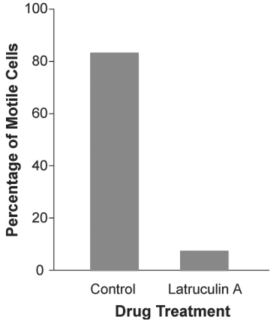A) The common ancestor of all protists evolved into other eukaryotic groups.
B) Protists all share a common set of synapomorphies.
C) Protists are all more primitive than land plants and animals.
D) Protists do not share a single common ancestor.
E) All of the above answers apply.
Correct Answer

verified
Correct Answer
verified
Multiple Choice
According to the endosymbiotic theory,why was it adaptive for the larger (host) cell to keep the engulfed cell alive,rather than digesting it as food?
A) The engulfed cell provided the host cell with ATP.
B) The engulfed cell provided the host cell with carbon dioxide.
C) The engulfed cell allowed the host cell to metabolize glucose.
D) The host cell was able to survive anaerobic conditions with the engulfed cell alive.
E) The host cell would have been poisoned if it had digested the engulfed cell.
Correct Answer

verified
Correct Answer
verified
Multiple Choice
Consider the following points: (a) All excavates live in environments where oxygen availability is low;(b) all excavates lack mitochondria;and (c) all excavates have some mitochondrial genes.Based on this information,which of the following statements is true of the excavate lineage?
A) Their ancestors were eukaryotes that existed prior to the origin of mitochondria.
B) Their ancestors had mitochondria,but the mitochondria were lost over time.
C) Their ancestors were not able to metabolize glucose.
D) Excavates are in the process of acquiring mitochondria through evolutionary adaptation.
Correct Answer

verified
Correct Answer
verified
Multiple Choice
Which of the major lineages of eukaryotes contain pronounced "feeding grooves" for digesting prey or organic debris?
A) Plantae
B) Excavata
C) Alveotata
D) Rhizaria
Correct Answer

verified
Correct Answer
verified
Multiple Choice
How was primary productivity measured in the phytoplankton experiment?
A) net CO₂ uptake
B) the number of cells produced
C) net CO₂ production
D) accumulation of mutations
Correct Answer

verified
Correct Answer
verified
Multiple Choice
Figure 29.2  -Refer to the figure above and consider the following data: Brown algae (protists) include unicellular and multicellular organisms.Red algae (protists) include unicellular and multicellular organisms.Amoebae (protists) include unicellular and multicellular organisms.Which of the following conclusions is consistent with the data presented?
-Refer to the figure above and consider the following data: Brown algae (protists) include unicellular and multicellular organisms.Red algae (protists) include unicellular and multicellular organisms.Amoebae (protists) include unicellular and multicellular organisms.Which of the following conclusions is consistent with the data presented?
A) Multicellularity is a synapomorphy that defines a eukaryote.
B) Multicellularity evolved once;thus,animals are derived from the most recently evolved protists.
C) Multicellularity evolved multiple times as eukaryotes diversified.
D) Multicellularity is more adaptive than unicellularity.
E) None of the above answers apply.
Correct Answer

verified
Correct Answer
verified
Multiple Choice
The structure of protist flagella indicates that this structure evolved directly from the bacterial flagella.
A) true
B) false
Correct Answer

verified
Correct Answer
verified
Multiple Choice
Protists belong to the domain Eukarya.Which of the following is not a protist?
A) kelp
B) red algae
C) yeast
D) diatoms
Correct Answer

verified
Correct Answer
verified
Multiple Choice
You discover a new lineage of protists.You examine several species of this lineage under the microscope and find a distinctive feature that sets them apart from other protists.Following the nomenclature style used to name the lineage Discicristata,you decide to name this new lineage Spherocristata.What is the distinctive feature that is reflected in the name?
A) a perfectly round nucleus
B) spherical cristae within their mitochondria
C) flagella that beat in a circle
D) spherical thylakoids within their chloroplasts
E) perfectly round lysosomes
Correct Answer

verified
Correct Answer
verified
Multiple Choice
Consider the following data: (a) Most ancient eukaryotes are unicellular.(b) All eukaryotes alive today have a nucleus and cytoskeleton.(c) Most ancient eukaryotes lack a cell wall.Which of the following conclusions could reasonably follow the data presented?
A) The first eukaryote may have been very similar to a plant cell.
B) The first eukaryote may have been anaerobic.
C) The first eukaryote may have been capable of phagocytosis.
D) The first eukaryote may have been photosynthetic.
Correct Answer

verified
C
Correct Answer
verified
Multiple Choice
A particular species of protist lacks the ability to engulf food and does not contain chloroplasts.However,gene sequencing data indicate that this species evolved from a lineage containing many species with the ability to engulf food.What does this information suggest about this species of protist?
A) It probably reproduces asexually.
B) It is likely parasitic.
C) It is likely aquatic.
D) It probably eats bacteria.
Correct Answer

verified
B
Correct Answer
verified
Multiple Choice
Which of the following characteristics is true of all protists?
A) contain a nucleus
B) smaller than animal cells
C) unicellular
D) have a cell wall
E) photosynthetic
Correct Answer

verified
Correct Answer
verified
Multiple Choice
Encouraging the growth (via nutrient fertilization) of photosynthetic protists in marine environments may help reduce global warming.Why?
A) Photosynthetic protists give off a lot of carbon dioxide,and fertilizing them would increase carbon dioxide levels in the atmosphere.
B) Photosynthetic protists fix atmospheric carbon dioxide,decreasing carbon dioxide levels in the atmosphere.
C) Photosynthetic protists use a lot of oxygen,and fertilizing them would decrease oxygen levels in the environment.
D) Photosynthetic protists would release a lot of oxygen,and fertilizing them would increase levels of oxygen in the atmosphere.
Correct Answer

verified
Correct Answer
verified
Multiple Choice
Which of the following groups is matched with an incorrect anatomical feature?
A) foraminifera → tests with holes
B) dinoflagellata → two flagella
C) oomycota → apical complex
D) diatoms → silicon-rich tests
E) phaeophyta → exclusively multicellular
Correct Answer

verified
Correct Answer
verified
Multiple Choice
Cultures of the same species of diatom referred to in the previous question were treated with BDM,a reversible inhibitor of myosin function.Which of the following predictions is consistent with the hypothesis that an actin-myosin interaction is necessary for motility?
A) BDM will significantly decrease motility of the cells in culture.
B) BDM will not significantly alter motility of the cells in culture.
C) BDM will significantly increase motility of the cells in culture.
Correct Answer

verified
A
Correct Answer
verified
Multiple Choice
Which of the following observations about flagella is true and is consistent with the scientific conclusion that the flagella from protists and bacteria evolved independently?
A) Both flagella are made of the same protein,but the configuration is different.
B) The mechanics of movement and protein structure are the same in these flagella,but there are significant genetic differences.
C) Although the mechanism of movement in both flagella is the same,the protein that accomplishes the movement is different.
D) The protein structure and the mechanism of movement in protist flagella are different from those of bacteria flagella.
Correct Answer

verified
Correct Answer
verified
Multiple Choice
Latrunculin A is a reversible toxin that disrupts the formation of actin fibers.A culture of a particular species of diatom was treated with this toxin diluted in a buffer,while another culture was treated only with the buffer (no toxin;control) .The motility of cells in each culture was assessed by counting the number of cells that were moving during a defined period of time.Which of the following conclusion statements is reasonable based on the data in the bar graph presented below? 
A) Formation of actin fibers is not necessary for the movement in this species of diatom.
B) The buffer alone largely inhibited movement in this species of diatom.
C) In this species of diatom,fully formed actin fibers are necessary for movement.
Correct Answer

verified
Correct Answer
verified
Multiple Choice
Which of the following would be considered a carbon sink that could potentially reduce atmospheric carbon dioxide to help alleviate global warming?
A) calcium carbonate
B) petroleum
C) sedimentary rocks
D) all of the above
Correct Answer

verified
Correct Answer
verified
Multiple Choice
The dinoflagellate Pfiesteria piscicida can feed off algae and bacteria.They can also "steal" intact chloroplasts from algae and become photosynthetic.In the presence of large amounts of fish,Pfiesteria can secrete a toxin that kills fish,allowing it to feed on decaying fish matter.How would you classify this species?
A) predator
B) primary producer
C) detritivore
D) all of the above
E) A and C only
Correct Answer

verified
Correct Answer
verified
Multiple Choice
Assume that some members of an aquatic species of motile,photosynthetic protists evolve to become parasitic to fish.They gain the ability to live in the fish gut,absorbing nutrients as the fish digests food.Over time,which of the following phenotypic changes would you expect to observe in this population of protists?
A) loss of motility
B) loss of chloroplasts
C) gain of a rigid cell wall
D) gain of meiosis
E) no changes would be expected
Correct Answer

verified
Correct Answer
verified
Showing 1 - 20 of 36
Related Exams